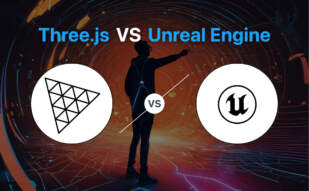If your focus is premium 3D game development, choose Unreal Engine with its high-fidelity graphics engine and C++ base. Opt for JavaScript for robust browser-centric applications with immediate user feedback and network-oriented benefits.

Key Differences Between Unreal Engine and JavaScript
- Unreal Engine is tailored for 3D game development, supporting diverse platforms, while JavaScript is primarily designed for building dynamic, interactive web pages.
- Unreal Engine is written in C++, while JavaScript is an interpreted, object-oriented programming language.
- Unreal Engine charges 5% of revenues over USD 1 million for commercial use, whereas JavaScript is freely used for web or server-side with Node.js.
- Unreal Engine incorporates a level editor and Unreal Development Kit supporting iOS game creation, whereas JavaScript is employed in renowned products like Facebook, Twitter, Netflix, and Google.
| Comparison | Unreal Engine | JavaScript |
|---|---|---|
| Initial Release | 1998 – Unreal Engine 1 | 1995 – LiveScript |
| Type | 3D computer graphics game engine | Dynamic computer programming language |
| Use Cases | PC first-person shooters, other game genres, film and TV, VR | Website interactivity, user interfaces, server-side scripting with Node.js, mobile apps |
| Primary Language | C++ | Javascript |
| Development Kit | Unreal Development Kit available freely, supports creating iOS games | Development tools include Microsoft FrontPage, Macromedia Dreamweaver MX, Node.js |
| Licensing Costs | 5% of revenues over USD 1 million for commercial use. Free for schools and universities | Free |
| First Product Release | Daylight Game using Unreal Engine 4 | Netscape 2.0 |
| Companies Using Technology | Epic Games | Facebook, Twitter, Netflix, Google |
What Is Unreal Engine and Who’s It For?
Unreal Engine (UE) is an influential series of 3D computer graphics game engines developed by Epic Games since 1998. Although initially created for PC first-person shooters, UE has grown and now supports a vast array of platforms, including VR, and is used across various industries. You will find it in films, TV and, of course, in numerous video games across genres.
Leveraging a powerful level editor, UnrealEd, UE enables developers to craft immersive worlds with real-time constructive solid geometry operations. Whether you’re an indie game creator, a triple-A studio, or a film producer, UE provides the visual fidelity and technical agility needed to bring artistic visions to life.

Pros of Unreal Engine
- Powers wide range of platforms: desktop, mobile, console, VR.
- Flexible for various industries, beyond gaming to film and TV.
- Robust level editor, UnrealEd, supports real-time constructive operations.
- Generous developer revenue shares from its marketplace (88%).
- Free for schools and universities.
Cons of Unreal Engine
- Charges 5% of revenue for products that make over $1M.
- High system requirements for running the latest versions smoothly.
- Steep learning curve for beginners such as C++ usage.
What Is JavaScript and Who’s It For?
JavaScript is a lightweight, dynamic computer programming language. Rose to prominence as the backbone of interactivity on the web, it transformed static web pages to dynamic experiences. Born in 1995 and stewarded by Netscape, JavaScript’s standard definition is enshrined in the ECMAScript standard.
Today, companies like Google, Facebook, and Twitter use JavaScript to boost user-friendliness on their platforms. Also, JavaScript’s abilities have expanded beyond just websites – it’s now used in creating mobile apps and in server-side processing thanks to Node.js. This makes JavaScript the go-to skill for web developers, app developers, and even back-end developers.

Pros of JavaScript
- Enables dynamic, interactive web content.
- Pervasive, embedded in nearly every web browser.
- Supports server-side tasks thanks to Node.js.
- Immediate, client-side user validation reduces server interaction.
Cons of JavaScript
- No direct file system access for security reasons.
- No multi-threading or multiprocessor capabilities.
- Learning curve for mastering asynchronous programing.
Code Examples for Unreal Engine & JavaScript
Unreal Engine
Our Unreal Engine example introduces the process of creating a simple boundary box toggle, useful in debugging invisible walls or spatial limitations in your level. Ensure you’re working within Unreal Engine 4.25+ for compatibility purposes.
// This function toggles the visibility of a boundary box in Unreal Engine
void AMyClass::ToggleBoundaryBox(){
if(MyBoundaryBox->GetVisibility()){
MyBoundaryBox->SetVisibility(false);
}
else{
MyBoundaryBox->SetVisibility(true);
}
}JavaScript
The following JavaScript example showcases the implementation of a basic 3D sphere using Three.js. Note, Three.js must be included in your project’s dependencies to seamlessly execute this snippet.
// create the size and geometry of the sphere
var radius = 5;
var segments = 32;
var rings = 32;
// Create a new mesh with sphere geometry.
var sphere = new THREE.Mesh(
new THREE.SphereGeometry(radius, segments, rings),
new THREE.MeshLambertMaterial({
color: 0xCC0000
})
);
// Add it to the scene, position it and render
scene.add(sphere);
sphere.position.set(0, 10, 0);
renderer.render(scene, camera);Unreal Engine vs JavaScript | The Epic Showdown
When the cutting edge of game engine technology meets the ubiquity of web platform programming, who takes the gold? Here’s how Unreal Engine and JavaScript stack up.
Professional Game Developers
Unreal Engine, with its powerful, feature-rich platform, and C++ foundation, should be the go-to choice. Its potency for creating immersive 3D experiences is unmatched, coupled with a wide platform support spectrum, from desktop to virtual reality.

Mod Creators and Hobbyists
For those stepping into the gaming scene at a more conservative pace, Unreal Engine’s mod-creator friendly environment and available basic templates make the learning process a breeze. Plus, easing the royalty-model for Epic Games Store publishers is a financial windfall.

Interactive Web Developers
When it comes to enhancing website interactivity, JavaScript reigns supreme. Given its omnipresence, you can exploit its capabilities for creating dynamic HTML content and validating user inputs swiftly, delivering a seamless user experience.

Backend Development
From cloud-based platforms to server-side applications, JavaScript, by way of Node.js, becomes an alluring choice for backend development. Big names like Google, Twitter, and Netflix leveraging JavaScript highlight its credibility.

Ultimately, Unreal Engine shines for enriched 3D game development, and JavaScript excel at enhancing web interactivity and server-side programming. Choose as per your craft’s demands.
Tiffany Brise
Content writer @ Aircada, patiently awaiting a consumer AR headset that doesn’t suck.





